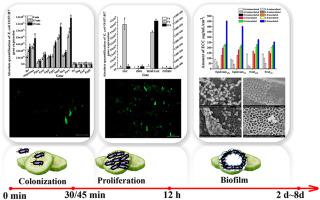Food Microbiology ( IF 4.5 ) Pub Date : 2021-08-13 , DOI: 10.1016/j.fm.2021.103885 Yeting Sun 1 , Yue Ma 2 , Hongyang Guan 2 , Hao Liang 3 , Xiaoyan Zhao 4 , Dan Wang 4

|
Cucumber is usually eaten as a raw vegetable and easily contaminated by pathogenic microorganisms; the contamination process includes colonization, proliferation, and biofilm formation. In this study, plate counting was used to determine the stage of E. coli O157:H7 colonization/proliferation in cucumber epidermis and fruit. Expression of E. coli genes associated with adhesion, movement and oxidative stress response during colonization and proliferation in cucumber was evaluated with fluorescence real-time quantitative PCR. Scanning electron microscopy imaging was used to observe biofilm formation over time in different cucumber tissues at 4 °C and 25 °C. During colonization (at 0–45 and 0–30 min in epidermis and fruit, respectively), fliC, espA, escN, espF, espG, espZ, nleA, tir, and chaperone genes were upregulated. The escC was downregulated, while map and espH expression did not vary. During proliferation (after 45 and 30 min in epidermis and fruit, respectively), fliC was downregulated, whereas the outer membrane protein intimin gene and oxidative stress genes rpoS and sodB were upregulated. During storage, 25 °C was more favorable for biofilm formation than 4 °C. The ability of biofilm formation on the vascular system was the strongest, and the biofilm on epidermis sloughed off earlier than that on other tissues. Clarifying the process of E. coli O157:H7 contaminating cucumbers provided useful information for the development of prevention and control methods of fresh-cut cucumber.
中文翻译:

大肠杆菌O157:H7在感染黄瓜(Cucumis sativus L.)中的粘附机制和生物膜形成
黄瓜通常作为生蔬菜食用,容易被病原微生物污染;污染过程包括定殖、增殖和生物膜形成。在这项研究中,平板计数用于确定大肠杆菌O157:H7 在黄瓜表皮和果实中定殖/增殖的阶段。用荧光实时定量PCR评估了在黄瓜定植和增殖过程中与粘附、运动和氧化应激反应相关的大肠杆菌基因的表达。扫描电子显微镜成像用于观察 4 °C 和 25 °C 下不同黄瓜组织中生物膜随时间的形成。在定殖期间(分别在表皮和果实中的 0-45 和 0-30 分钟),fliC,espA、escN、espF、espG、espZ、nleA、tir和伴侣基因被上调。escC被下调,而map和 e spH表达没有变化。在增殖过程中(分别在表皮和果实中 45 和 30 分钟后),fliC被下调,而外膜蛋白 intimin 基因和氧化应激基因rpoS和sodB被上调。在储存期间,25°C 比 4°C 更有利于生物膜的形成。血管系统的生物膜形成能力最强,表皮上的生物膜比其他组织上的生物膜脱落得更早。阐明大肠杆菌O157:H7污染黄瓜的过程,为制定鲜切黄瓜防控方法提供了有益信息。











































 京公网安备 11010802027423号
京公网安备 11010802027423号